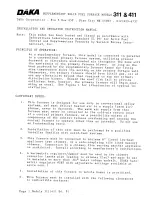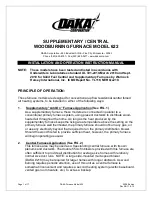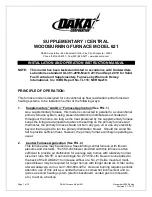
Page | 25
CHIMNEY AND FLUE PIPE MAINTENANCE
Chimney Maintenance
Cleaning your chimney is not a difficult task; however, we recommend a professional do
this job. A professional chimney sweep can detect problems in your system that you might
not recognize.
Flue Pipe Maintenance
If you are connecting your unit to a masonry or premanufactured chimney you should use
24-gauge or thicker pipe (the thicker the pipe that is used, the longer it will last). This pipe
will require some maintenance, and it should be cleaned as needed. A chimney sweep
can do this job and also evaluate when the pipe needs replacing.
Note: It is a good practice to clean your flue system in the spring to eliminate any
lingering odor through the summer months.
THINGS THAT COULD CAUSE THE UNIT TO SMOKE
It is very important that all pipe connections be made airtight. This can be done with stove
cement (or high-temperature silicon) and sheet metal screws at each pipe joint. If the
joints are not airtight, air can be drawn through these areas, affecting the efficiency and/or
safety of the unit. Ideally, all combustion air will be drawn through the outside air hook-up.
If there is a clean-out door on your chimney, this should also be sealed in some manner to
make it airtight.
Downdrafts: One cause for chimney downdrafts is air being deflected down the chimney
by nearby objects such as the roof, trees or a nearby hill. Another cause is flue gas being
chilled as it passes through the flue system. A typical example of this would be the flue
system cooling down and the smoke not being able to exit the system, thereby building up
in the chimney. The chimney will then “back puff” if there is wind blowing across the top of
the flue system. This situation can normally be avoided if the furnace runs at a sustained
temperature, thus not allowing the system to cool down.
Smoke
Detectors
England’s
Stove
Works,
Inc.
highly
recommends
the
use
of
smoke
detectors
in
every
room
of
the
house.
However,
locating
a
smoke
detector
directly
above
this
unit
can
result
in
nuisance
alarms.
Meets the 2015 U.S. Environmental Protection Agency’s crib wood emission
limits for wood heaters sold after May 15, 2015
Summary of Contents for 28-4000
Page 33: ...Page 33...
Page 69: ...Page 33...
















































